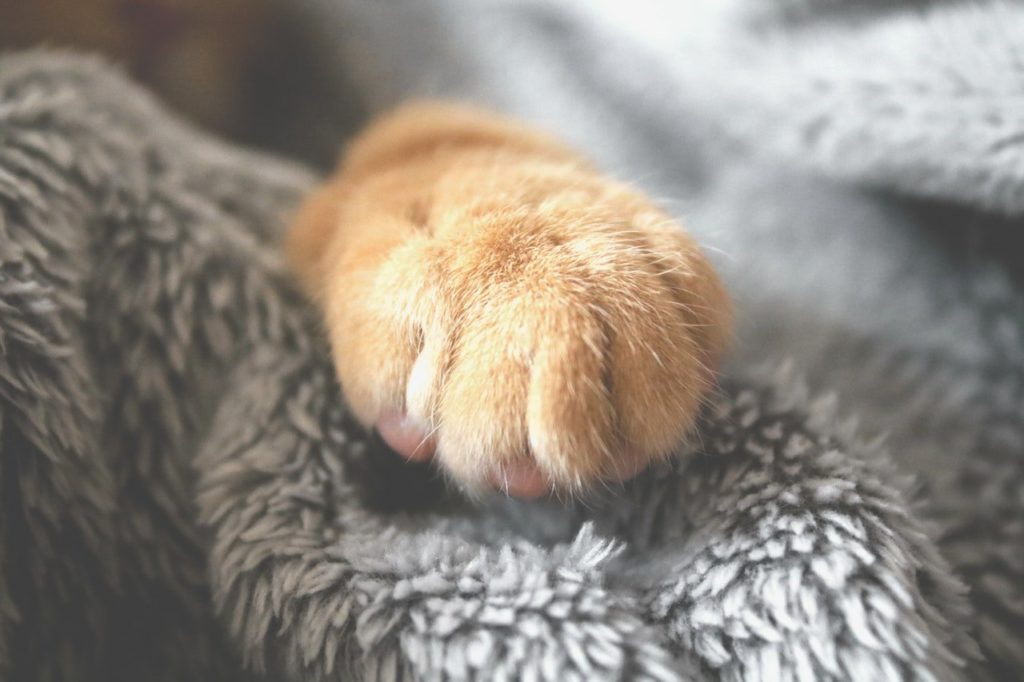Similar to our fingernails, cat nails grow throughout their lives. And if you’re a cat owner, you’ve likely glimpsed your feline, sharpening those claws throughout the day. (Hopefully on an approved cat scratcher or scratching post) When you’re spending time snuggling with your fluffy friend, nothing kills the mood like punctures into your leg or arm. Kneading means contentment, but those nails? Yeouch! You’d like to take the tips off, but trimming cat nails makes you nervous. What if you cut too far and cause harm? Where to make the proper cut? And what tool works best? If this cat grooming necessity has you stymied, you’ve come to the right place. We’ll have you trimming cat nails like a pro in no time!
Feline Paw Anatomy
Unlike dogs, cats have retractable claws. This means they can withdraw the claw back into a “pocket” within the toe. (Canines – and cheetahs! – keep their nails out at all times) This adaptation allowed wild cats to approach their prey on soft feet. It also prevented them from getting caught on the forest floor during a burst of speed. (In contrast, cheetahs use their claws as “traction spikes” when they get up to speed).
If you look at your cat’s nail, you’ll notice two layers:
- White/Clear: The outer layer is the protective sheath of the claw. It helps them hook into climbing surfaces, snag their toys, or even dig into their food.
- Pink: The inner layer is also known as the quick. It holds the nerves and blood vessels supplying the muscles that help with retraction and extension.
Cats have a total of eighteen nails: four claws and a dewclaw on each of their front feet and four claws on their hind feet. This the average – polydactyl cats are an exception.
In the wild, cats naturally blunt their nails through climbing and chasing down their meals. This prevents the claws from curling around into the paw pad. Indoor cats, though, don’t have the same luxury. Instead, their claws grow continuously, sharpening into nasty hooks that curve around. When you hear that distinctive tapping as your cat walks across the floor or see them snag a blanket, you know it’s time for a trim.
Desensitizing Paws
That retractability makes trimming cat nails a little tricky, as you need to gently push the nail forward. This means holding your kitty’s paws. If you start this process when they’re kittens, you’ll find it easier than if you wait until they’re an adult. However, that doesn’t mean you need to give up if you brought an older cat into the household. You may just need to pack on some extra time and patience.
Before you ever reach for cat nail trimmers, set yourself up for success. Find somewhere quiet and calm. You want as few distractions as possible (especially with younger cats) and aim for a time when your kitty feels relaxed and cooperative. (A full tummy should do the trick) If you or your feline friend feel grouchy, wait for another time.
- Touch one of your cat’s paws. If they allow it, offer a yummy treat.
- Next, move to gently massaging that same paw. (Always work ONE paw at a time) If your kitten starts trying to play, stop there. You don’t want them to think this is a game, or you could find yourself fending off teeth come nail-trim time. Again, reward with praise and a treat.
- Now comes the tricky part: Carefully press down on the toe to extend the claw. You won’t need to apply much pressure and let go as soon as you see the nail. Offer a treat.
- Continue working with your cat once a day until you’ve extended every claw.
Once your kiddo accepts the manipulation of their feet, you’re ready to move on to the BIG step – breaking out those nail clippers!

Types of Cat Nail Trimmers
When it comes to trimming cat nails, you have a few options:
- Dremel: While you’ll see plenty of commercials boasting about cat dremels, I recommend you skip this option. Even with dogs, dremels require A LOT of practice to use appropriately. They’re loud, and cats don’t appreciate the sound or the vibration so close to their feet. Not to mention that regular use of dremels can lead to carpal tunnel syndrome for YOU.
- Guillotine: Guillotine cat trimmers take some practice. As you might guess from the name, they require you to line the claw up within a window before squeezing the handle shut. You hold the trimmer perpendicular to your cat’s toe. If your cat’s patient while you get that alignment perfect, you’re probably fine. But squirmy felines tend to bolt while you’re working.
- Human Nail Clippers: Many people prefer ordinary human nail clippers. They’re small enough to work on tiny cat paws, and the stainless steel blades remain nice and sharp. You need to remember to hold them sideways (not upright as you would for yourself), but they’re an acceptable option.
- “Professional”/Pliers: Plier-style cat trimmers show up in stores marketed under the “professional” name. Why? They’re the style groomers, and veterinarians prefer. They function on a spring-powered grip. Sizing may have limitations, and you need to consider quality when you make your purchase.
- Scissors: As you might guess, scissor nail trimmers resemble a pair of scissors, and the action is the same. You’ll find a variety of sizes, even an itty-bitty category for cats and kittens. Take quality into account when you buy, though, as it DOES matter.
Ultimately, you need to go with what feels the most comfortable for YOU. We prefer the scissors style in our house, mostly because they’re the easiest to use. (We have a plier-style for our Greyhound)
Trimming Cat Nails
Your cat doesn’t mind you touching their paws, and you have the cat nail trimmer that works for you. Now it’s time to knuckle down and start the process of trimming your cat’s nails. If you’re still feeling edgy, take a deep breath. It’s okay if you only get a couple of nails done at a time. Work over a few days until you get all of them finished. As you – and your cat – gain confidence, you’ll get the process down to a science. And as you trim the nail back, the quick will start receding, as well. So even if you’re starting with an older cat with long, thick nails, it’s possible to train the quick back over months of careful routine.
Now, deep breathe in, deep breath out. Let’s get to work!
Trimming Cat Nails: Cat Positioning
Every cat’s different in their acceptance of how to sit for a nail trim. Some will relax on your lap without a problem – especially if you started them as a kitten. Others may need some gentle restraint by residing in the crook of your arm. You’ll keep one hand free to work the clippers. If your kitty tolerates, you can also hold them upside down in your lap. (This is what I do with my cats)
For the grumpier cats out there, having a second set of hands is always a bonus. One person holds the feline while the other person wields the clippers. You’ll have a chance to work faster, and your helper can distract the cat with chin skritches or even treats.
If you have a cat that absolutely HATES the process of trimming cat nails, consider investing in a cat bag or use the kitty burrito method. While not ideal, these options keep you protected from flailing paws. My parents have a little tripod cat who turns into a monster when we trim her nails, and the only way everyone makes it out alive is when she’s wrapped in a towel. (After which, she returns to being a loving, sweet cat)
Trimming Cat Nails: The Clip
Gently extend the first nail. You can start anywhere, on any foot. If you establish a routine, though, your cat will learn the process. (Remember, cats are brilliant, and they pick up on patterns) Look for the difference between the white and pink on the nail. You NEVER want to cut into that quick. You’ll cause the nail to bleed, your cat will experience pain, and you’ll probably scare yourself (personal experience).
When you’re first starting, just take the sharp tip from the nail. As you gain confidence with trimming cat nails, you’ll start to gain an idea of how much of the nail to remove. (You can go just above the quick)
As soon as you clip, release the claw and give your cat a treat. If your cat’s still tolerating their position, continue. Some cats will let you get through all of the nails without a problem. Others will call it quits after two or three. Let your feline friend call the shots. DON’T force your cat to stay if they’re upset; you don’t want to make nail trimming a negative experience when you’ve worked this hard.

“I Cut the Quick!”
You look down and notice some drops of blood on your lap. Or your cat yowls the second the clippers click. Your heart stops.
You’ve cut into the quick!
As scary as it is, it’s not the end of the world. And, unhappily, the odds are you’ll do it at least once trimming cat nails. You CAN do something about it, and having one of the following on hand each time you start a nail trim will help ease that panic:
- Cornstarch
- Dry bar of soap
- Styptic powder
- Styptic sticks
As soon as you find the affected nail, press one of the remedies against it until the bleeding stops. If you use the bar of soap, gently rub the nail against the bar to create a “patch.” They’re painless methods of encouraging a clot to form. For medical personnel out there, NEVER use silver nitrate sticks! They BURN, and your cat will hate you!
Trimming Cat Nails: Frequency
Every cat’s different. On average, most cats need a nail trim about once a month. However, there are exceptions to that rule:
- Arthritic Cats: It’s painful for cats with arthritis to have their feet manipulated. Try to extend nail trims to every TWO MONTHS.
- Outdoor Cats: NEVER cut their nails! Their claws will stay under control through their normal activities. Besides, they need those claws for climbing and defense.
- Young Cats: As kittens enter their rapid growth phase, their claws follow suit. You’ll find you can trim their nails every TEN DAYS.
Again, though, each cat’s an individual. Our youngest cat needs her nails trimmed every two weeks. (We swear she has a nail file hidden away somewhere) Make it a habit to take a look at your cat’s claws every couple of weeks to see if they need the sharp hook removed. Or you can simply wait until you notice those telltale signs a trim’s needed.
The Declaw Debate
Trimming cat nails involves time, patience, and a lot of work. Many people prefer to skip it, taking their cat to the vet for a professional “spa day.” Others choose to use alternative options, such as Soft Paws, which prevent their cat from scratching. However, they DON’T stop the cat’s claws from growing.
And then you find people that think it’s easier to declaw their cat and skip the process entirely.
Declawing is NOT what it sounds like. Rather than removing the claw, declawing involves the AMPUTATION of the final digit of your cat’s toe. It’s an inhumane procedure that often leads to SEVERE complications for the cat. Their feet no longer touch the ground as they did before (leading to back problems), they may develop bone spurs, and infections and other surgical complications can result. Even worse, without the normal means of defending themselves, many declawed cats become fear-biters.
If trimming cat nails feels overwhelming to you, consider getting in touch with a professional. Your vet, a groomer, or even a family friend is ALWAYS better than subjecting your cat to the horrific experience of declawing.
My parents don’t feel comfortable trimming their cat’s nails, and I go over there every month to pitch in. I don’t mind a bit – even if it means the feisty one growls at me the whole time within her towel.
Mani-Pedi Time
Your cat keeps getting stuck in the blanket. Or you hear a lovely tap dance across the kitchen floor at mealtimes. You know those sharp cat claws need a blunting – for everyone’s sake. But you’re not afraid of trimming cat nails anymore because now you have all of the tools you need. Stay calm, keep the treats close by, and remember that even three nails at a time are a success. The more you work through the process, the better you’ll get.
And even if your cat doesn’t show it, they’ll appreciate it when their toy no longer adheres to their paw.













No comment yet, add your voice below!